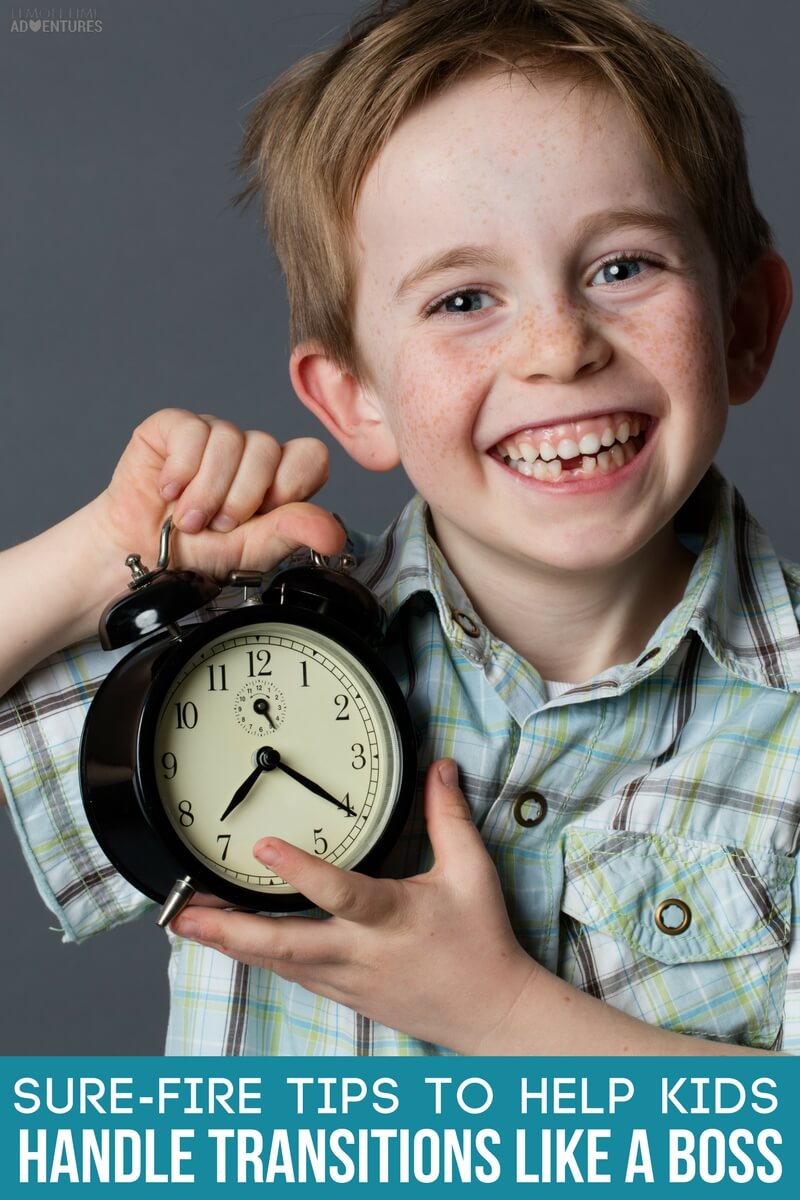What if you were in the middle of something really important and I demanded that you stop right this instance and do something for me? You would look at me like I was crazy, right? How would it make you feel if I didn’t let up, and kept nagging you to stop right now and do what I needed? You might start to feel your blood boil and your muscles start to tense up. Lucky for you, that doesn’t happen too often to you as an adult, but it does happen to your kids all day long.
Transitions (the change between two activities) can be extremely emotional and frustrating for children, typically resulting in ugly behavior, tantrums and arguments. What if I told you that you can add a few simple steps to your day to help kids handle transitions like a boss and end these battles once and for all?

* This post may contain affiliate links for your convenience. Click here for my full disclosure.
Why are Transitions So Hard for Kids?
Think back to the last time you needed to get a few things done around your house, or better yet, think about your typical day at work or home. Could you make it through that day if I took away your phone, your calendar, and a notebook to jot your lists down on? Would you be able to survive if I took away your visual tools to help you organize your day and reminders to complete your projects? Probably not.
How would you feel if you showed up to work one day and your boss came to you unexpectedly and told you that it was time to leave and go across town to work at a new office. Or what if as soon as you started your project, she turned off your computer and told you to read a new article. You might actually lose your mind if this happened over and over again all day long, every day.
Yet, we do this with our children all the time. Turn off the tv, get ready for dinner, clean up the playroom or get ready for school are common requests we give our children without thinking much about it. When we are met with tantrums, meltdowns, talk back or defiance, we are usually confused and take it personally. When in fact, our children simply need a little help with transitioning through these changes.
So, what is the answer? How can we help our kids and give them the same courtesies we would like as adults?
Sure-fire Tips to Help Kids Handle Transitions Like a Boss
The good news is that there is hope for all of us and simple changes we can make today to help our kids (and us) handle these changes in our schedule and these simple daily requests.
Create a Specific Routine
I cannot stress the importance of a regular routine for your child enough. Think about how much more in control you feel when your work week is the same and predictable. You know that Monday through Friday, you will get up, get the kids ready for school, take the kids to school, go to work, pick up the kids from school, make dinner, help with homework, clean the house and get the kids ready for bed. Your days are pretty routine and similar. This structure helps you manage the chaos that is really happening behind each of those steps.
Children need this repetition just as badly as we need it as adults. By setting a structured schedule and routine in place for your family, your children can begin to know what to expect and predict will happen day to day.
Give Visual Reminders
Humans are naturally visual creatures and children (especially children with neurological differences) rely heavily on visual cues to gather information and make judgements about the world around them.
Visual schedules are simple tools to help children make sense of their activities and daily tasks in a visually represented way. You might have heard of visual schedules as being used with children on the spectrum or with developmental delays, however visual schedules can be beneficial and extremely helpful for many children.
Some of our favorite ways to do this in our home are through our family command center, visual binders, and printable routine cards.
Give Advanced Warnings
So often, when we need to change activities, we head over to our kids and say “Okay, time to clean up.” When we are met with resistance, we automatically feel like our children are disrespecting us, when the truth is our kids are trying to process the request you just made and are frustrated by the abrupt change in the schedule. Remember, our children are extremely visual and time is a very abstract concept. Sometimes giving a verbal warning just isn’t enough for our children, which is why I suggest a visual timer where children can literally see the time passing. This is our favorite visual timer, we use these every single day.
Give Children Some Control
One of the best tips for successful transitions and ending power struggles is to allow your children to choose and have a say in their daily schedule. By adding in a small choice, children feel like they have some control and feel respected, which will result in less battles and more connection for the two of you. This can be done by setting very specific options your child gets to choose from. For example, when it is time to clean, you can say “We need to clean this room, would you like to put away the Lego or the building blocks”. When it is time to get ready to end a game or activity, you can suggest “We need to leave in just a little while, would you like 5 more minutes to play or 10 more minutes.” While this will take a little bit of pre-planning on your end, it will help your child feel included.
Make the Transition Physical
So often, we give all of our instructions verbally, pushing our kids through their day. When your child is required to transition from one activity to another, you can ease this transition by having them physically doing something to show they completed the transition. This can be moving a routine card, checking off a box, or closing a tab to indicate something on a list is finished. Think about just how satisfying it can be to check things off your “to do” lists. This is very similar to that action for your child.
Finally, practice and be patient. Don’t expect to see a magical change over night. You and your child will have to get used to these new expectations and routines. However, I promise you that once you get the the hang of it, include your child in the process and give your child the same support you would want, your kid will begin to handle transitions like a boss.

If you found this helpful, you will LOVE our free poster pack. Discover how to get your defiant child to listen and do what you ask — all without threats, bribes, or punishments.
Download the free ‘Do What You Ask’ posters now!






